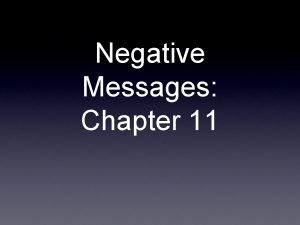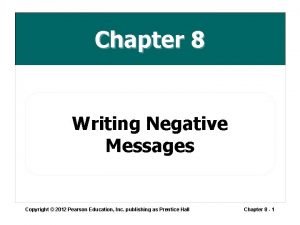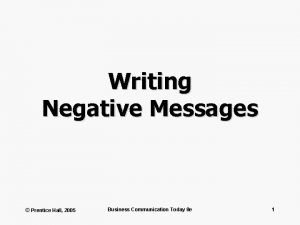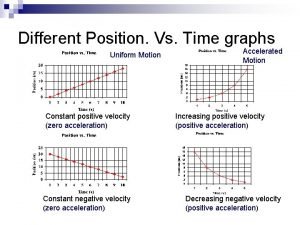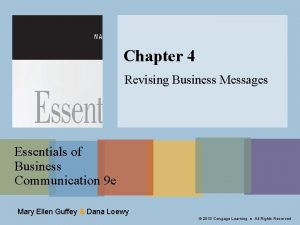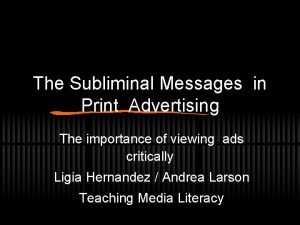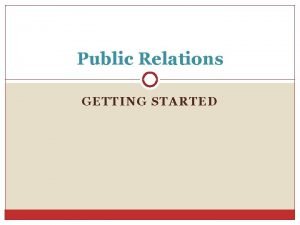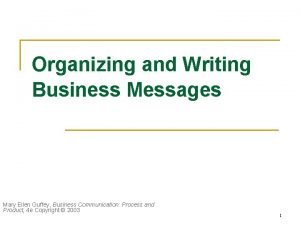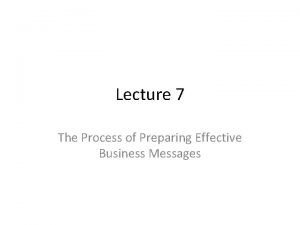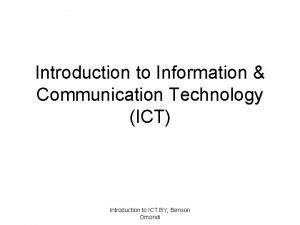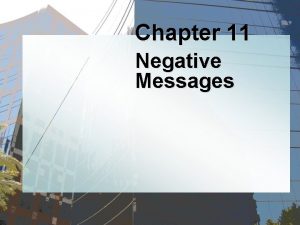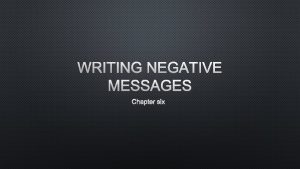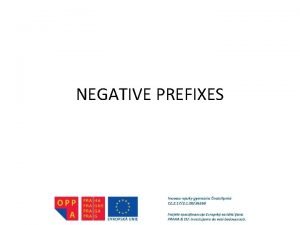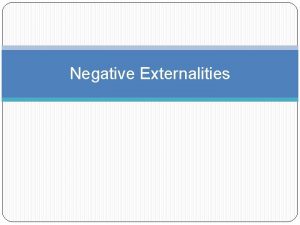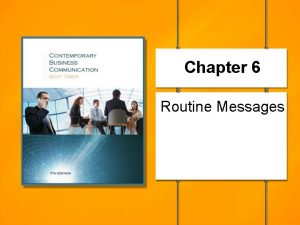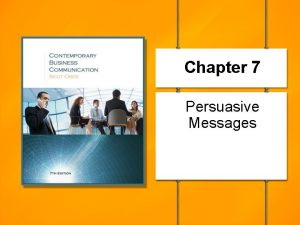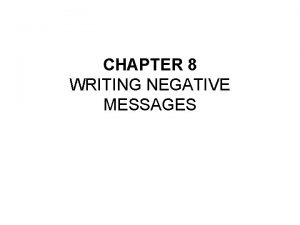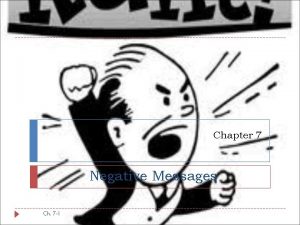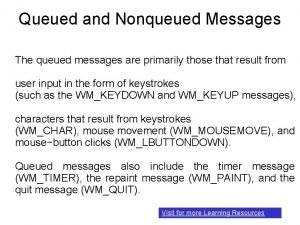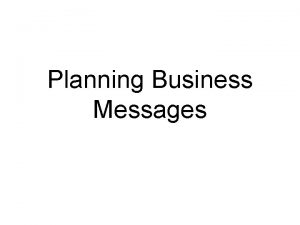Chapter 9 Negative Messages Topics in This Chapter



































- Slides: 35

Chapter 9 Negative Messages

Topics in This Chapter Goals in Communicating Negative News Applying the 3 -x-3 Writing Process for Negative Messages Avoiding Legal Liability in Conveying Bad News Direct Strategy for Delivering Bad News Indirect Strategy for Delivering Bad News Ch. 9, Slide 2 © 2011 Cengage Learning. All Rights Reserved. May not be scanned, copied or duplicated, or posted to a publicly accessible website, in whole or in part.

Topics in This Chapter Components of Effective Negative Messages Techniques for Delivering Bad News Sensitively Dealing With Disappointed Customers Managing Bad News on Social Networking Sites Announcing Rate Increases and Price Hikes Delivering Bad News Within Organizations Ch. 9, Slide 3 © 2011 Cengage Learning. All Rights Reserved. May not be scanned, copied or duplicated, or posted to a publicly accessible website, in whole or in part.

Goals in Communicating Negative News § Explaining clearly and completely § Projecting a professional image of you and your organization § Conveying empathy and sensitivity § Being fair § Maintaining friendly relations Ch. 9, Slide 4 © 2011 Cengage Learning. All Rights Reserved. May not be scanned, copied or duplicated, or posted to a publicly accessible website, in whole or in part.

Applying the 3 -x-3 Writing Process to Negative Messages § Phase 1: Analyze, Anticipate, Adapt § Analyze the bad news. § Anticipate its effect on the receiver. § Announce the bad news directly if the disappointment will be mild. § Use techniques to reduce the pain if the bad news is serious. Ch. 9, Slide 5 © 2011 Cengage Learning. All Rights Reserved. May not be scanned, copied or duplicated, or posted to a publicly accessible website, in whole or in part.

Applying the 3 -x-3 Writing Process to Negative Messages § Phase 2: Research, Organize, Compose § Gather information and brainstorm for ideas. § Jot down all reasons you have to explain the bad news. Ch. 9, Slide 6 © 2011 Cengage Learning. All Rights Reserved. May not be scanned, copied or duplicated, or posted to a publicly accessible website, in whole or in part.

Applying the 3 -x-3 Writing Process to Negative Messages § Phase 2: Research, Organize, Compose § Present only the strongest and safest reasons. § Include ample explanation of the negative situation. § Avoid fixing blame. Ch. 9, Slide 7 © 2011 Cengage Learning. All Rights Reserved. May not be scanned, copied or duplicated, or posted to a publicly accessible website, in whole or in part.

Applying the 3 -x-3 Writing Process to Negative Messages § Phase 3: Revise, Proofread, Evaluate § Read the message carefully to ensure that it says what you intend. § Check the wording to be sure you are concise without being abrupt. § Read the sentences to see if they sound like conversation and flow smoothly. Ch. 9, Slide 8 © 2011 Cengage Learning. All Rights Reserved. May not be scanned, copied or duplicated, or posted to a publicly accessible website, in whole or in part.

Applying the 3 -x-3 Writing Process to Negative Messages § Phase 3: Revise, Proofread, Evaluate § Make sure the tone is friendly and respectful to increase receiver acceptance. § Check format, grammar, and mechanics. § Evaluate the message. Is it too blunt? Too subtle? Is it clear, but professional? Ch. 9, Slide 9 © 2011 Cengage Learning. All Rights Reserved. May not be scanned, copied or duplicated, or posted to a publicly accessible website, in whole or in part.

Avoiding Legal Liability in Conveying Negative News § Abusive language, including abusive language on social networking sites, such as Facebook and Twitter Libel Slander written spoken defamation Defamation - language that harms a person’s reputation Ch. 9, Slide 10 © 2011 Cengage Learning. All Rights Reserved. May not be scanned, copied or duplicated, or posted to a publicly accessible website, in whole or in part.

Avoiding Legal Liability in Conveying Negative News § Careless language – statements that are potentially damaging or subject to misinterpretation § For example, The factory is too hazardous for tour groups Ch. 9, Slide 11 © 2011 Cengage Learning. All Rights Reserved. May not be scanned, copied or duplicated, or posted to a publicly accessible website, in whole or in part.

Avoiding Legal Liability in Conveying Negative News § The good-guy syndrome - dangerous statements that ease your conscience or make you look good § For example, (I thought you were an excellent candidate, but we had to hire…) § Express only the views of the organization when acting as an agent of the organization. § Use plain paper for your personal matters. § Avoid supplying information that could be misused. § Don’t admit or imply responsibility without Ch. 9, Slide 12 checking with legal counsel. © 2011 Cengage Learning. All Rights Reserved. May not be scanned, copied or duplicated, or posted to a publicly accessible website, in whole or in part.

Comparing Strategies for Delivering Negative News § Direct Strategy § Indirect Strategy Bad News Buffer Reason s Reasons Bad News Pleasant Close Pleasan t Close Ch. 9, Slide 13 © 2011 Cengage Learning. All Rights Reserved. May not be scanned, copied or duplicated, or posted to a publicly accessible website, in whole or in part.

When to Use the Direct Strategy § When the bad news is not damaging § When receiver may overlook the bad news § When the organization or receiver prefers directness § When firmness is necessary Ch. 9, Slide 14 © 2011 Cengage Learning. All Rights Reserved. May not be scanned, copied or duplicated, or posted to a publicly accessible website, in whole or in part.

When to Use the Indirect Strategy § When the bad news is personally upsetting § When the bad news will provoke a hostile reaction § When the bad news threatens the customer relationship § When the bad news is unexpected Ch. 9, Slide 15 © 2011 Cengage Learning. All Rights Reserved. May not be scanned, copied or duplicated, or posted to a publicly accessible website, in whole or in part.

Examining the Components of Effective Negative Messages Bad News Buffer • A neutral or positive opening that does not reveal the bad news Reasons • An explanation of the causes for the bad news Closing • A clear but understated announcement of the bad news that may include an alternative or compromise • A personalized, forwardlooking, pleasant statement Ch. 9, Slide 16 © 2011 Cengage Learning. All Rights Reserved. May not be scanned, copied or duplicated, or posted to a publicly accessible website, in whole or in part.

Techniques for Delivering Bad News Sensitively Buffering the Opening § § Presenting the Reasons Cushioning the Bad News Closing Pleasantly Start with the part of the message that represents the best news. Pay a compliment, show appreciation for a past action, or refer to something mutually understood. Avoid raising false hopes or thanking the receiver for something you are about to refuse. Consider apologizing if you or your company erred. If you apologize, do so sincerely and take responsibility. Ch. 9, Slide 17 © 2011 Cengage Learning. All Rights Reserved. May not be scanned, copied or duplicated, or posted to a publicly accessible website, in whole or in part.

Techniques for Delivering Bad News Sensitively Buffering the Opening § § Presenting the Reasons Cushioning the Bad News Closing Pleasantly Explain clearly why the request must be denied without revealing the refusal. Show your decision benefits the receiver or others, if possible. Explain company policy without using it as an excuse. Choose positive words. Avoid negative words, such as cannot, claim, error, failure, unwilling, impossible. Ch. 9, Slide 18 Show that the matter was treated seriously and © 2011 Cengage Learning. All Rights Reserved. May not be scanned, copied or duplicated, or posted to a publicly accessible website, in whole or in part. §

Techniques for Delivering Bad News Sensitively Buffering the Opening § § § Presenting the Reasons Cushioning the Bad News Closing Pleasantly Consider positioning the bad news strategically by sandwiching it between other sentences. Consider subordinating the bad news (although another commitment that day prevents me from attending, I wish you well in …). Consider using the passive voice (although I am prevented from attending because of another commitment that day, . . . ). Ch. 9, Slide 19 © 2011 Cengage Learning. All Rights Reserved. May not be scanned, copied or duplicated, or posted to a publicly accessible website, in whole or in part.

Techniques for Delivering Bad News Sensitively Buffering the Opening § § § Presenting the Reasons Cushioning the Bad News Closing Pleasantly Accentuate the positive by describing what you can do, not what you can’t do. Consider implying the refusal, but be certain it is clear. Suggest a compromise or an alternative, if one exists. Ch. 9, Slide 20 © 2011 Cengage Learning. All Rights Reserved. May not be scanned, copied or duplicated, or posted to a publicly accessible website, in whole or in part.

Techniques for Delivering Bad News Sensitively Buffering the Opening § § § Presenting the Reasons Cushioning the Bad News Closing Pleasantly Look forward to future relations. Supply more information about an alternative, if one is offered. Offer good wishes, compliments, or freebies (coupons, samples, gifts). Avoid referring to the refusal. Use resale or sales promotion if appropriate. Ch. 9, Slide 21 © 2011 Cengage Learning. All Rights Reserved. May not be scanned, copied or duplicated, or posted to a publicly accessible website, in whole or in part.

Damage Control: Dealing With Disappointed Customers § Call the individual involved. § Describe the problem and apologize. § Explain § Why the problem occurred § What you are doing to resolve it § How you will prevent it from happening again § Follow up with a letter that documents the phone call and promotes goodwill. Ch. 9, Slide 22 © 2011 Cengage Learning. All Rights Reserved. May not be scanned, copied or duplicated, or posted to a publicly accessible website, in whole or in part.

“Before” – Ineffective Customer Request Refusal Dear Ms. Trumbo: We regret to inform you that we cannot allow you to convert the lease payments you have been making on your Canon X 1000 color copier toward its purchase, much as we would love to do so. We understand that you have been making regular payments for the past 16 months. Our established company policy prohibits such conversion of leasing monies. Perhaps you have noticed that we offer extremely low leasing and purchase prices. Obviously, these low prices would never be possible if we agreed to many proposals such as yours. Because we are striving to stay in business, we cannot agree to your request asking us to convert all 16 months of rental payments toward the purchase of our popular new equipment. It is our understanding, Ms. Trumbo, that you have had the Canon X 1000 color copier for 16 months, and you claim that it has been reliable and versatile. We would like to tell you about another Canon model—one that is perhaps closer to your limited budget. Sincerely, Ch. 9, Slide 23 © 2011 Cengage Learning. All Rights Reserved. May not be scanned, copied or duplicated, or posted to a publicly accessible website, in whole or in part.

Critical Thinking Questions 1. What is the purpose of the letter on the previous slide? What goals should the sender have? 2. What prevents this letter from achieving those goals? 3. What pattern of development would work best for this letter? Is that pattern what you see? Ch. 9, Slide 24 © 2011 Cengage Learning. All Rights Reserved. May not be scanned, copied or duplicated, or posted to a publicly accessible website, in whole or in part.

Critical Thinking Questions 4. What idea could serve as a buffer to open an improved version of this letter? Write a buffer. 5. How could the bad news be subordinated? Write a statement that subordinates the bad news. 6. What friendly news could be used in the closing? Write a closing statement. Ch. 9, Slide 25 © 2011 Cengage Learning. All Rights Reserved. May not be scanned, copied or duplicated, or posted to a publicly accessible website, in whole or in part.

“After” – Improved Refusal of Request Dear Ms. Trumbo: We’re happy to learn that you are enjoying the use of the Canon X 1000 color copier you’ve been leasing for the past 16 months. Like our many other customers, Ms. Trumbo, you have discovered that Canon copiers supply remarkable versatility and reliability. One of the reasons we’re able to offer these outstanding copiers at such low leasing rates and equally low purchase prices is that we maintain a slim profit margin. If our program included a provision for applying lease payments toward purchase prices, our overall prices would have to be higher. Although lease payments cannot be credited toward purchase price, we can offer you other Canon models that are within your price range. The Canon 600 delivers the same reliability with nearly as many features as the top-of-the-line Canon X 1000. Please let us demonstrate the Canon 600 to your staff in your office, Ms. Trumbo. Our representative, Seth Simmons, will call you during the week of May 5 to arrange an appointment. Sincerely, Ch. 9, Slide 26 © 2011 Cengage Learning. All Rights Reserved. May not be scanned, copied or duplicated, or posted to a publicly accessible website, in whole or in part.

Managing Organizational Negative News on Facebook, Twitter, and Other Web Sites § Recognize social networks as an emerging communication channel. § Become proactive by establishing blogs and active Web sites with community forums to listen to customers and advertise the company's good deeds. Ch. 9, Slide 27 © 2011 Cengage Learning. All Rights Reserved. May not be scanned, copied or duplicated, or posted to a publicly accessible website, in whole or in part.

Managing Organizational Negative News on Facebook, Twitter, and Other Web Sites § Join sites, such as Twitter, Facebook, Flickr, You. Tube, and Linked. In to see how these sites function and to benefit from site interaction. § Monitor comments about your organization to make immediate response possible. By John S. Donnellan Ch. 9, Slide 28 © 2011 Cengage Learning. All Rights Reserved. May not be scanned, copied or duplicated, or posted to a publicly accessible website, in whole or in part.

Announcing Rate Increases and Price Hikes § Explain the reason for the price increase, such as higher material costs or rising taxes. § Convey how the increase will add new value or better features, make use more efficient, or make customers’ lives easier. § Give (advance) warning of rate increases. Ch. 9, Slide 29 © 2011 Cengage Learning. All Rights Reserved. May not be scanned, copied or duplicated, or posted to a publicly accessible website, in whole or in part.

In Today’s Digital Environment, Rate and Price Increases May Be Announced Online Explains expansion of Bluray DVD movie collection and describes how costly these films are, thus justifying a price increase Connects increase in cost to bigger library and wider choice of best movies for customers Ch. 9, Slide 30 © 2011 Cengage Learning. All Rights Reserved. May not be scanned, copied or duplicated, or posted to a publicly accessible website, in whole or in part.

In Today’s Digital Environment, Rate and Price Increases May Be Announced Online Provides name and number for more information Ch. 9, Slide 31 © 2011 Cengage Learning. All Rights Reserved. May not be scanned, copied or duplicated, or posted to a publicly accessible website, in whole or in part.

Techniques for Delivering Bad News Personally to a Superior Gather all the information. Prepare and rehearse. Explain what happened and how the problem will be repaired. Consider taking a colleague with you. Think about timing. Be patient with the reaction. Ch. 9, Slide 32 © 2011 Cengage Learning. All Rights Reserved. May not be scanned, copied or duplicated, or posted to a publicly accessible website, in whole or in part.

Techniques for Delivering Bad News to Groups of Employees § § Deliver the news honestly and early. Use the indirect strategy. Try to open with a relevant, upbeat buffer. Provide clear, convincing reasons that explain the decision. § Be clear, yet kind, gentle, and understated with the bad news. § Avoid referring to the bad news in the closing. Ch. 9, Slide 33 © 2011 Cengage Learning. All Rights Reserved. May not be scanned, copied or duplicated, or posted to a publicly accessible website, in whole or in part.

Techniques for Refusing Job Applicants § To avoid being painful to the receiver and, more importantly, to avoid providing extra information that may prove fatal in a lawsuit, keep letters short, general, and tactful. Ch. 9, Slide 34 © 2011 Cengage Learning. All Rights Reserved. May not be scanned, copied or duplicated, or posted to a publicly accessible website, in whole or in part.

END Ch. 9, Slide 35 © 2011 Cengage Learning. All Rights Reserved. May not be scanned, copied or duplicated, or posted to a publicly accessible website, in whole or in part.
 Bad news messages in business communication
Bad news messages in business communication What is negative message
What is negative message Indirect approach for negative messages example
Indirect approach for negative messages example Writing negative messages in business communication
Writing negative messages in business communication Adding of integers
Adding of integers Negative velocity negative acceleration
Negative velocity negative acceleration Constant leftward velocity
Constant leftward velocity Chapter 4 revising business messages answers
Chapter 4 revising business messages answers Chapter 2 planning business messages
Chapter 2 planning business messages Three step writing process in business communication
Three step writing process in business communication Chapter 9 topics in analytic geometry
Chapter 9 topics in analytic geometry Camel cigarette subliminal messages
Camel cigarette subliminal messages Hidden messages in water
Hidden messages in water Indent messages ali
Indent messages ali Skl army
Skl army Routine messages examples
Routine messages examples Discharge messages safewards
Discharge messages safewards What is routine letter
What is routine letter What is para verbal
What is para verbal Pr messages
Pr messages Planning business messages adalah
Planning business messages adalah Materi revisi pesan bisnis
Materi revisi pesan bisnis Example of academic text
Example of academic text Oracle streams
Oracle streams Multidatagram messages are
Multidatagram messages are Implicit message examples
Implicit message examples 5 planning steps of effective business messages
5 planning steps of effective business messages Leadership messages examples
Leadership messages examples Introduction of ict
Introduction of ict Epic in basket messages
Epic in basket messages Testimonial
Testimonial I-messages definition
I-messages definition Messages of goodwill
Messages of goodwill Aidc messages
Aidc messages Part of the eye that sends messages to the brain
Part of the eye that sends messages to the brain Preferred senders of change messages
Preferred senders of change messages

